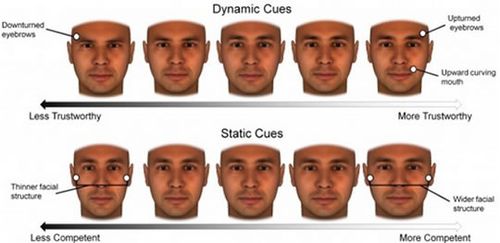By Dr. Ken Broda Bahm:
Think about your face. There are 43 muscles there, and even now as you’re reading this post, some are tensed and some are at rest. The resulting combination is what we call “expression.” That unique configuration of facial muscles is used as a basis for some very quick judgments — quicker than conscious processing — about you: your personality traits including competence, warmth, intelligence, and seriousness, and also your more transitory states such as your mood and intentions. All that is, as they say, “written all over your face” and ready to be read by the next person who sees you. Now, chances are, no one is studying your face when you are on your own reading excellent blog posts. But you can bet that when you’re either advocating or testifying in trial or deposition, your target audience will be scrutinizing and will have no choice but to interpret and to be influenced by what your facial expressions are saying. Given the high stress that often accompanies legal proceedings, that expression sometimes carries a dominant message of tension: Narrowed eyes, a furrowed brow, a tight mouth, along with general rigidity in the rest of your features risks conveying unease, irritation, arrogance, or a lack of confidence.
I would never coach someone to “act” with their face as part of their testimony or their courtroom presentation. That’s because most attorneys and witnesses are not actors, and even for the few who are, it is simply too important to look and to feel natural, and too risky to come off as false. As with other aspects of nonverbal communication, it is not a matter of pretending, but rather a matter of reducing bad habits. Wearing your tension on your face is one of those bad habits. The solution is to relax and present a relatively neutral visage. I say “relatively” neutral because, interpretation being inevitable, no expression is ever fully neutral. But you do want a resting expression that communicates credibility and avoids tension. A new study (Hehman, Flake & Freeman, 2015) provides advice on exactly what that expression is. The study is handily written up in a recent post in Jeremy Dean’s Psyblog, and my post will share that news — including an image of that ideal face — along with some recommendations for the advocate and the witness.
The Research: Facing Up to a Subtle Difference
Looking at the qualities of faces that are considered credible, the study tested both static features (things you’re born with) and dynamic features (things you change by moving your face). Focusing on those things that you can change through effective communication (and not through expensive cosmetic surgery), the bottom line result is this: A face with slightly upturned mouth and slightly lifted eyebrows, along with an otherwise neutral expression, is more trustworthy.
Here are the different images used in the study.
One thing that leaps out from that image, particularly the top half that we’re discussing, is that the differences are pretty darned subtle. And I think that is an appropriate reminder for courtroom communication: We aren’t talking about mugging for the audience by using any kind of dramatic or obvious facial expressions. Instead, we are talking about small differences that make a statistically significant difference nonetheless.
So the figure on the top right is what you’re after as a near-neutral resting position. Jeremy Dean calls it a smile in his Psyblog piece, but I don’t agree. Mona Lisa is positively grinning compared to that. Instead, it is just a slight upturn to the mouth and a slight raising of the eyebrows.
Recommendations: Mind Your Face
One way of handling facial expression is to rely on the mind-body connection: Feel it and, to some extent at least, it is reflected in your expression. And the feelings you are going for are “calm,” “attentive,” and “positive.” But as important as that connection is, it isn’t perfect. I’ve talked to witnesses who claim to be completely calm, yet are still wearing an expression that says that they just learned they’re being audited by the IRS. So here are a few common sense practices for managing your facial expressions.
Exercise
The first step is to be aware of your facial muscles. Here is a good way to do that (in privacy, not on the stand). First, pinch your face: Try to bring your brows and your mouth into the smallest possible spot at the tip of your nose. Then, widen your face: Get your eyebrows and mouth as far away from each other as possible. A quick online search will show you some examples of actors’ use of this ‘raisin and banana’ technique. It not only helps you stretch, but it also provides a reminder of what your facial muscles are doing.
Watch
Whether you’re presenting or testifying, chances are that your thoughts are on your content, not on your face. That is why it is a good idea to practice separately, and then just relax and rely on your previously-established good habits once it comes time to speak in court. Standing in front of a mirror and simply evaluating your resting position isn’t a bad idea. Compare it to the study images above, aiming for the subtle but positive top right-hand image. Beyond that, video is an exceptional tool for evaluating how you come across. Freeze the image and ask yourself what you see. If possible, get second and third opinions from others as well.
Vary
Before I finish this piece, I want to make sure it is clear that no one is recommending a single frozen expression for the duration of the time you’re speaking or testifying. A resting position is just that — it’s a default expression for those times when you’re not intending to convey anything different. But at various times, particularly for the advocate but also for the witness, there will be good reasons to convey other emotions: concern, anger, disbelief, sadness, and even humor. Don’t get too carried away with it, of course, but do allow your face to show your feelings at key times. But for the rest of the time, go for a face that isn’t tense, but is instead relaxed and relatively neutral.
______
Other Posts on Nonverbal Communication:
- Treat Body Language as Unproven, Yet Trusted
- Don’t Be Too Sure About Face Reading Your Jury
- Adapt to Inconsistent Assessments of Witness Demeanor
______
Hehman, E., Flake, J. K., & Freeman, J. B. (2015). Static and Dynamic Facial Cues Differentially Affect the Consistency of Social Evaluations. Personality and Social Psychology Bulletin, 0146167215591495.
Photo Credit: Buster Benson, Flickr Creative Commons
author

